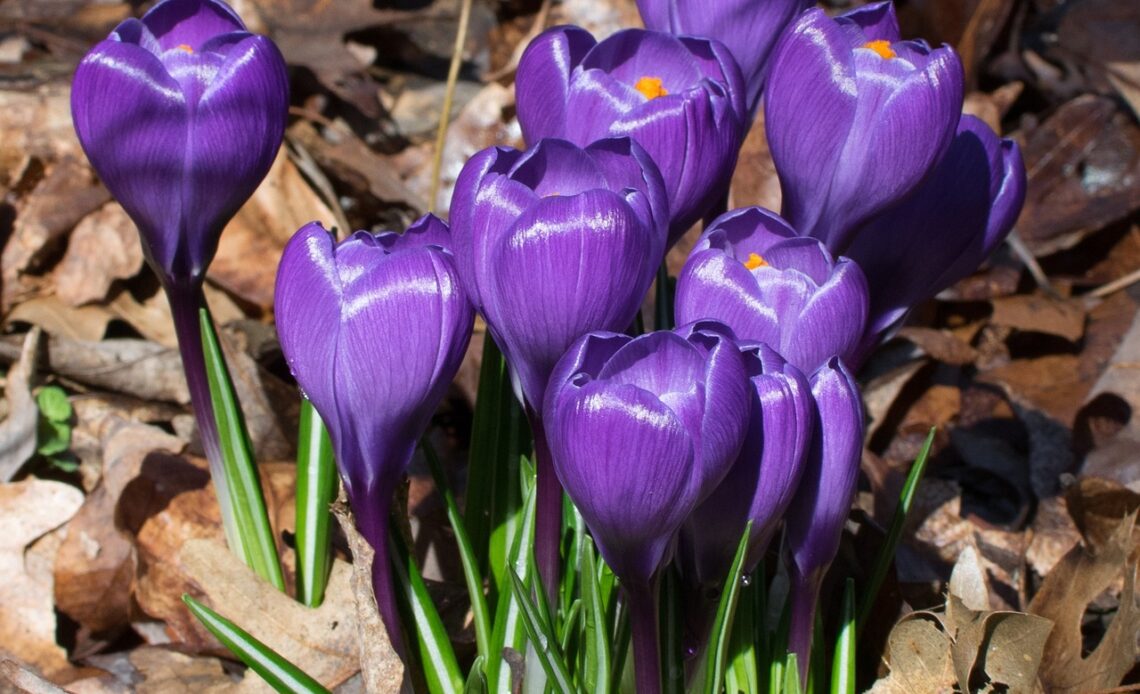
Planting crocus bulbs is a simple process that even beginner gardeners can handle. When choosing a location for your crocuses, it’s important to select an area with well-draining soil and plenty of sunlight or partial shade. Once you’ve picked a spot, it’s time to prepare the soil. Dig the soil to a depth of six inches and add compost or organic matter to improve soil quality.
When planting your crocus bulbs, be sure to plant them in the fall before the first frost. Dig holes that are three to four inches deep and two to three inches apart. Place the bulbs in the holes with the pointed end facing upwards, then cover them with soil and water well.
Once your crocus bulbs have been planted, they require very little care. Water them occasionally during dry spells, and fertilize them in the fall. After the flowers have bloomed, deadhead them to encourage more growth next year.
When spring arrives, you’ll be rewarded with beautiful crocus blooms in a variety of colors. These flowers are not only a lovely addition to any garden, but also make for great indoor arrangements. So, plant your crocus bulbs following these easy steps and enjoy their beauty!
Choosing the Right Location
When choosing a location in your garden to plant your crocus bulbs, it’s important to keep in mind that they require well-draining soil and full sun or partial shade for optimal growth. Make sure the area you choose does not have standing water or become waterlogged after rain.
If you have heavy clay soil, consider amending it with compost or organic matter to improve drainage and nutrient content. Crocus bulbs do not like wet feet and will rot in poorly drained soil.
Additionally, crocus bulbs should be planted in an area with good air circulation to help prevent diseases like Botrytis. This fungus can cause grey, fuzzy patches on the leaves and flowers of the plant and can be avoided by planting in areas with good air flow.
Preparing the Soil
To ensure successful growth for your crocus bulbs, it is important to prepare the soil properly. Start by digging the soil to a depth of 6 inches, breaking up any clumps and removing any rocks or weeds. Mix in compost or organic matter to improve the soil’s fertility and drainage.
If your soil is heavy or has poor drainage, consider adding sand or perlite to improve the soil’s texture. It is important that the soil is well-draining to prevent the bulbs from rotting.
Before planting, make sure the soil is moist but not waterlogged. If the soil is too dry, water it a few days before planting. Once the soil is ready, you can start planting your crocus bulbs. Remember to space them 2-3 inches apart and plant them with the pointed end facing upwards.
With the right soil preparation, your crocus bulbs will have a strong start and produce stunning blooms.
Planting the Bulbs
If you want to enjoy beautiful crocus flowers in your garden, you need to plant the bulbs correctly. The best time to plant crocus bulbs is before the first frost in the fall. When planting, dig holes that are 3-4 inches deep and 2-3 inches apart. Place the bulbs in the holes with the pointed end facing upwards. This will ensure that the flowers bloom properly.
After placing the bulbs in the holes, cover them with soil and water them well. Keep in mind that crocus bulbs need well-draining soil to prevent them from rotting. You can also add some organic matter or compost to the soil before planting to improve the quality.
Once you’ve planted the crocus bulbs, they will need minimal care. Water them occasionally during dry spells and fertilize them in the fall. Deadheading the flowers after they bloom will encourage more growth next year. With these simple steps, you’ll be able to enjoy beautiful and colorful crocus flowers in your garden year after year.
Caring for Crocus Bulbs
Once planted, crocus bulbs require very little care. But, to ensure the optimal growth, there are a few things you can do. Water your crocus bulbs occasionally during dry spells, especially in the first year after planting. It’s important to make sure the soil stays moist, but not too wet.
Fertilize the bulbs in the fall with a balanced fertilizer to ensure they have enough nutrients to bloom in the spring. Deadhead the flowers after they’ve bloomed to encourage more growth next year. This means removing the spent blooms before they go to seed.
It’s important to note that crocus bulbs are toxic to dogs and cats, so make sure to keep them away from pets. With proper care, your crocus bulbs should continue to bloom and add a pop of color to your garden year after year.
Enjoying Your Crocus Bulbs
Once your crocus bulbs have bloomed in the spring, it’s time to enjoy their beauty in your garden. Crocus flowers are one of the first signs of spring and their bright colors are sure to lift your spirits. It’s also worth noting that crocus flowers are great for indoor arrangements, and they can be cut and brought indoors for a pop of color.
If you choose to cut your crocus flowers, make sure to wait until they have fully opened and cut them early in the morning. Immediately place them in a vase of water and keep them in a cool place away from direct sunlight. You can also mix crocus flowers with other spring flowers like daffodils and tulips for a beautiful arrangement.
Remember that crocus bulbs are perennial, meaning they will bloom year after year with proper care. Be sure to deadhead the flowers once they have bloomed to encourage more growth next year. Enjoy the beauty of your crocus bulbs both in your garden and in your home as you bring spring indoors.

